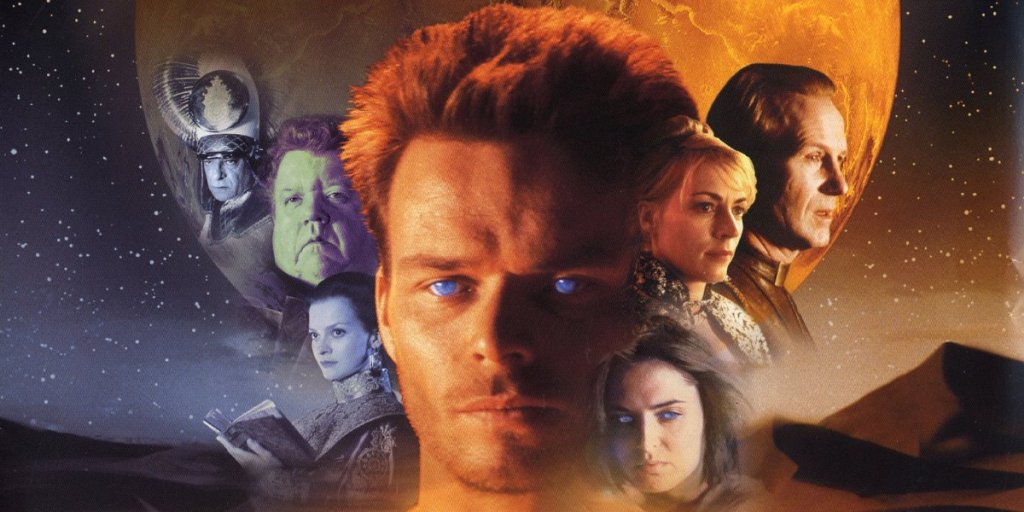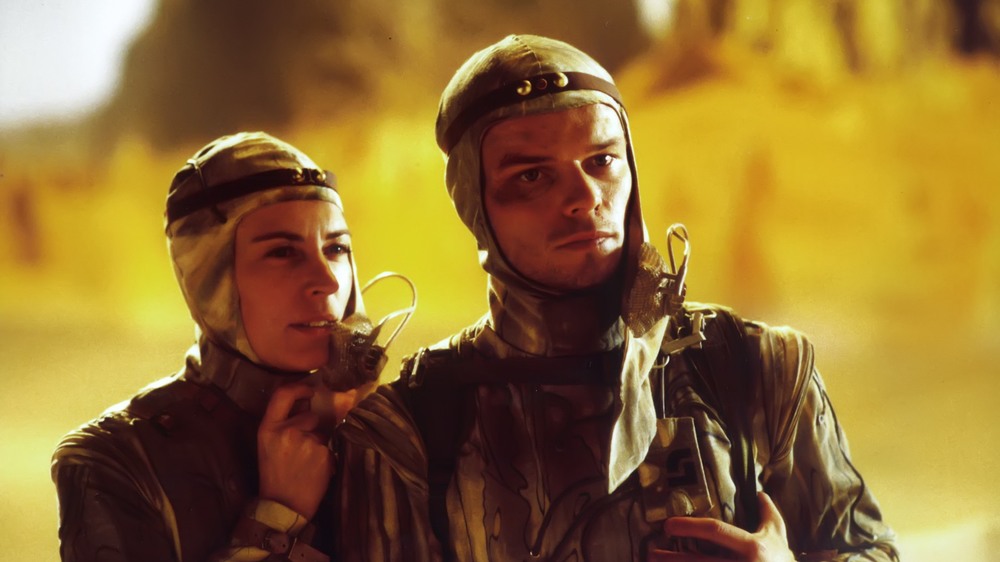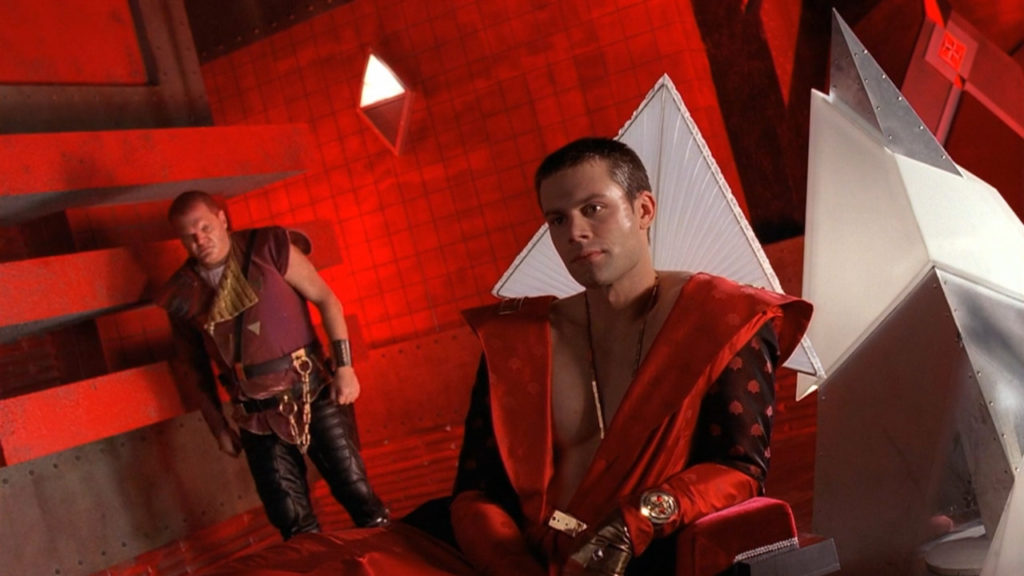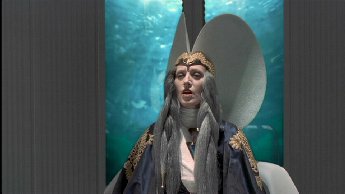
Sci-Fi Channel’s ‘Dune’ miniseries 2000: Gurney, Lady Jessica, Paul, Chani, Stilgar
Past and Future Leaders
As Paul reunites with his forces and prepares for the final confrontation, the ghost of Duke Leto (William Hurt, in a brief cameo) materializes before him to acknowledge his son’s progress from novice to leader.
This is the spot where Leto hands off the reins of power to his natural-born offspring. Consider this incident tantamount, if you don’t mind the Christian analogy, to Jesus receiving the Lord’s blessing from the Gospel of Matthew 3:17: “This is My beloved Son, whom I love. In Him I am well pleased.” Or, in a more literary realm (and in another context), the Ghost of Hamlet’s father paying a nocturnal visit to his namesake.
But the conflict between mother and son continues, both dredging up the past as they attempt to piece together what has come before – and, more importantly, what lies ahead. This is another key moment, in which the actors, Alec Newman as Paul Maud’Dib and Saskia Reeves as Lady Jessica, insisted they should perform on the fly (director John Harrison’s first thought was to cut the scene, but he wisely let it stand come airtime). The thrust of the argument is this: must the things they see come to pass, or can the future be changed?
A nuclear-style explosion and the participants’ attitudes and reaction to it give life to Paul’s “Second Coming.” The combination of parallel story lines culminating in Rabban’s death and the next chapter of Paul’s rise to leadership will lead the way. Note that the same little boy whose father was executed by Rabban as he cried out “Muad’Dib!” is the same one who carries the Beast’s severed head aloft in the prior scene. Hah! Payback’s a bitch, is it not?
Paul enters the Arrakeen palace with Stilgar and Otheym; the dead and dying bodies of the Sardaukar, the Emperor’s elite guards, are strewn about the great hall as lifeless monuments to the battle raging on outside and the resultant carnage within. The viciousness of the slaughter, the merciless manner in which the Fremen achieve their victory is presented in all their gory detail. “As graphic and savage as all wars deteriorate to,” according to Harrison’s commentary.
As Paul, Alec Newman has his head cocked to the left (or our right, as the viewer), his pale blue eyes glowing brightly, due to the spice’s miraculous properties. Paul, in the scene to come, will reiterate, with absolute conviction and certainty, that without the spice the Navigators will become blind, the Bene Gesserit will lose their grip, and all trade and commerce will cease to exist.
Then, after a short pause, Paul tilts his head to the right so as to show that he, as the head of the new order, will have changed the course of events for the planet Arrakis, if not that for every inhabitant. Subtly, too, Paul shifts his head once more, back to the left (and our right). We take this to mean the new order is now in place. Nothing can change what is coming.

Paul Atreides (Alec Newman) as Maud’ Dib, lays it all out in ‘Dune’ (2000)
We come now to the final confrontation between opposing forces. This is, without a doubt, the climax of the series – a fitting conclusion to the saga; a Greek tragedy of immense proportions, an Odyssey of a kindred sort, and a testament to those stories of old that we, as young adult readers, took most to heart. We stared at fantastic drawings and paintings, we marveled at recreations of heroes, heroines, villains and monsters, all of which stirred our imagination and thirst for ever more relatable fantasies.
Pretty boy Feyd Rautha will continue to taunt Paul with boastful threats of what he will do with Chani(!) after he takes possession of her. Chani, for her part, will reassure her consort that she does not fear the outcome of their clash. Indeed, none of us need be concerned, for the result has been preordained.
Still, Feyd is a most resourceful foe and not to be taken lightly: a vicious, cold-blooded killer and brute, like his badass brother Rabban before him, and overly confident of his abilities. But there’s something else that Feyd Rautha lacks that will give Paul the advantage in their duel to the death: and that is, the inevitability of fate and how it works to bring about that which has been foretold.
To be precise, it could have been any one of the participants: Stilgar, Otheym, Gurney Halleck, or the ferocious Fremen. The outcome would have still been the same: victory for their side. For prophecy has a way of working its insidious way into men’s minds. What about the minds of the women? Ah, there, too, we will find that, in the end, their voices will be the ones that matter.
For now, the die has been cast. The spice must flow.
To recap, Paul has entered the body-strewn palace with his forces. As he takes in the gory sights, he remembers what life in the palace was like prior to his father’s death. It has been many years since Paul Atreides has stepped onto these grounds. Finding his way into his parents’ quarters, Paul tries to comfort a weeping Chani.
“Tell me again about the waters in your homeland, Muad’Dib,” she asks poignantly. There is no triumph in her voice. No sense of victory, of a war being fought and won; only sadness and regret, despair at the loss of so many loved ones. What have they suffered through if not death and destruction? Despite all that, Paul describes to her the lushness of what he knows from his home world Caladan and how Arrakis will one day become.
Chani is overcome with grief and torment, along with thoughts of her slain son. She is inconsolable in the face of so much pain and loss. They embrace, warmly. “Then, it’s over?” Chani asks.
“Almost,” Paul replies.
Back to the throne room. Paul, in full regalia, is flanked by Gurney Halleck, Reverend Mother (and Lady) Jessica, and Chani by his side. Stilgar is also there, as is Otheym. They “greet,” if that’s the proper term (more like “receive”) the Padishah Emperor Shaddam IV, who treats Paul rather too dismissively for a failed head of state. The Emperor hints that, in a word, he can summon the other Great Houses to rally around to his cause. Bad move!
“Your word means nothing anymore,” is Paul’s curt retort.
Taken aback by this obvious insult to his person and power, Shaddam fires back: “I am the Emperor!”
“Not for long,” Paul responds calmly. He signals to his guards to bring in the representatives of the Spacing Guild, including the long-faced, lugubrious talking Guild agent, the one who Paul had captured earlier on.
The Spacing Guild agent does not take kindly to Paul’s bossing him around. But Paul, wiser than his years, informs the lot of them to look into the future, as they have the ability to do so. What do they see? Paul rises from his place on high and descends to their level. He paints a grim picture for them, if his orders are not obeyed – one of which is to destroy all spice production on Arrakis. If this is carried out, he claims, it will ruin the Spacing Guild and everyone else whose lifeblood depends on the spice’s flow.
It’s more radical that that! Paul threatens to bring death to the Makers – those giant sandworms out in the high desert, the ones who produce the spice, thus “killing the cycle of life.” This is an abomination, they howl. But Paul is deadly serious. It is no idle boast but a very real possibility. A catastrophe? Yes, by any means. But it’s much more than that: It is a blatant display of power and resolve. Paul means to have his way with the Spacing Guild and with the former “Great Houses,” if that’s what you want to call them.
In sum, Paul has them by the you-know-where and is perfectly capable of squeezing them for all they are worth. You can bet on it!

Cast of ‘Dune’ 2000 miniseries from the Sci-Fi Channel
The Reverend Mother Gaius Helen Mohiam is horrified. She angrily charges Lady Jessica to silence her son. But Jessica throws her taunt back in Reverend Mother’s face: “Silence him yourself!” The Emperor, fearing his hold on power is about to loosen, turns to the Spacing Guild agent to confirm if this can truly be done.
“They know I can do this,” Paul answers for them. “That’s what they fear the most.” As he says this, Paul approaches the disbelieving Emperor and what remains of his court and followers. “They know precisely where we are,” he gloats, his eyes glowing with a piercing blue light, “and what we can do.” Paul does not mince words. Things can get much, much worse.
In the end, Paul has used their methods against them: the very monopoly on trade and commerce that the Spacing Guild and the Great Houses have been resorting to for millennia will vanish overnight. Is this what they really want to happen, a reversal of who rules and who gets ruled? The worker bees become the bosses by governing the hive, while the queen and king become their slaves? Workers of the world, unite? And is Paul truly capable of burning down their houses?
“If I am not obeyed,” he goes on, “the spice…will not…flow.”
“It would be suicide!!!” the Emperor stammers out. Oh, yes. Indeed it would.
Stepping out from the crowd, the haughty Princess Irulan (only she’s not so haughty as she was before but rather looks upon Paul in a most admiring fashion) offers herself as a concession, a bargaining chip if you prefer; a gesture of peace and one the still irritated Emperor is loathe to accept.
Both Lady Jessica and the Emperor try their best to interfere. Neither is in agreement with this proposed solution. Yet, Irulan knows, probably better than anyone else, that the cards are stacked against them and in Paul’s favor.
“What choice do we have?” Looking at the Emperor with determination and forbearance, Princess Irulan tries one last time to convince him to go along with the idea: “Father, here is a man fit to be your son.”

Paul Atreides after combat with Feyd Rautha in ‘Dune’ miniseries 2000
Battle to the Death
Throwing in his own two cents, the still very-much-alive Feyd Rautha challenges Paul to a duel to the death. Paul turns to Gurney and asks who this rash fellow might be. Gurney fills him in on Fey’s ruthless nature and offers to kill the Baron’s last surviving nephew as a gift.
In his mind, Paul remembers his slaying of the rugged Jamis, his first unpleasant killing. He is not at all pleased by this turn of events, especially since he recently avoided a fight to the finish with Stilgar for leadership of the Fremen clans. But then, as Muad’Dib, he is in a very different position from where he was early on. He’s no doubt convinced himself that, as the Savior of his people, he has no choice but to accept the challenge of leadership – and before a receptive audience, too.
In another respect, Paul has been waging war for years. He is battle hardened and tested, a proven warrior to himself and to his men; while the Baron’s self-obsessed nephew is plainly a pretty boy – if a patently odious one; more of a prancing pony and a show-off, but a devious and dangerous adversary, nonetheless.
With all that occupying his thoughts, Paul is still able to strengthen his resolve, in the knowledge that, though he is mortal, his status and reputation as a leader will carry him through to victory. These are the differences that separate one combatant from the other.
Paul sighs to himself. “So it’s come to this,” he whispers, half to himself and half to Gurney and his retinue. Feyd demands satisfaction – and satisfaction, for lack of a better word, is what he will get. Their duel to the death becomes the climactic sequence to the entire saga, and the best scene in the series.
“May thy knife chip and shatter,” Paul relays to his opponent. It is the ritual cry of the Fremen to a fellow combatant, an acknowledgment that all are mortal and life is tenuous, held onto by a thread.
The Emperor offers his crysknife to Feyd as a gesture of support. Feyd accepts it and will fight in Shaddam IV’s name. Not satisfied with that, Feyd continues to issue off bald-faced threats at Muad’Dib, treating him with contempt and taunting his consort Chani for all it is worth. But Chani is not afraid.

Feyd Rautha, the Emperor, and Princess Irulan in finale to ‘Dune’ miniseries 2000
Paul goes through with the ritual. He takes his crysknife and folds it in his arms, crossing them across his bare chest. Feyd sneers at him. He appears smug and over-confident, which he must do if he is to hold up his end as defender of the late Baron Harkonnen’s fiefdom. They are both acting within the sphere and boundaries set forth by the feudal system they adhere to, and by their respective positions within that system.
Dark, foreboding shadows descend upon the throne room as the battle begins. The light continues to pour in from the right, making the duality of dark and shadow, right and wrong, that much more prominent. The stakes are, indeed, high.
Trans lights, which bathed the shadowy interior of the palace (a huge set, according to director-writer John Harrison) from the back and to the right, express both the darkness and foreboding of what has transpired and the coming out of that darkness into the light of “reason” and Paul’s pathbreaking ideas. It’s a superb use of staging, grouping, individual moments, and spotlighting specific to character and detail, along with the personal stakes involved in the developing story line.
Harrison did not want too many jump cuts in this action sequence, and no “whole hog” Matrix-y special FX either, as he phrased it in his commentary. But he also didn’t want to shy away from kung fu or other martial art form. The final result was a seamless blend of wide and medium shots. This gave credibility to the actors, who rehearsed this scene intensely over the course of several weeks.
In sum, this was the culmination of six months of shooting which, it must be mentioned, was worth the extra time and effort that were lavished on the entire project. The rudimentary CGI components, while not always seamlessly coordinated and at times sticking out prominently like the sorest of thumbs, nevertheless lent purpose and meaning to what could have been a dull, routine affair.
Paul gets the jump on Feyd when, after our pretty boy all-but appears to gain the upper hand, he hears Paul call out to him, using the name “cousin” (which Feyd was, as it was already revealed that the Baron was Lady Jessica’s father). This throws Feyd off his game, enough to distract him to the point that the younger Muad’Dib has thrust his crysknife deep into Feyd’s chest, killing him instantly. It’s all over at that point.

The victorious Paul (Alec Newman) and the Princess Irulan (Julie Cox) in ‘Dune’ miniseries
The Spacing Guild and the long-faced agent slink silently away and over to Paul’s side, accompanied by their gloomy-sounding exit music. The shocked Emperor sees his daughter, Princess Irulan, stride over to where Paul is standing. They eyeball each other for a brief instant as Irulan studies the victorious winner with hungry eyes. For his part, Paul joins Chani (his official consort) on the dais, while the Emperor strides slowly off and out the door – alone and unaccompanied.
Chani gazes lovingly at Paul, and he does likewise. As for Irulan, she is alone at the other end of the great hall, casting a very long shadow on the beautifully tiled palace floor – a power still, but only onto herself.
Lady Jessica, or Reverend Mother Jessica as she is now called, is given the final word. Yes, Jessica has survived. In fact, all the major women characters are the only ones to have lasted. Frank Herbert, the novelist and visionary exponent of the saga and its official sequels, was one the foremost auteurs of science fiction to have given women a prominent place in their stories. So it is only fitting that Lady Jessica summarizes the proceedings with her epitaph.
“There, so haughty, so confident,” Lady Jessica comments. “Let us hope she finds solace in her writing and her books. She’ll have little else.” Jessica continues: “She may have my son’s name, but it is we, the ones who carry the name of ‘concubine,’ that history will call ‘wives.’ ”
The story concludes with a replay of Grame Revell’s marvelous Middle Eastern-influenced scoring.
“The saga of Dune is far from over…”
(To be continued)
Copyright © 2024 by Josmar F. Lopes












































You must be logged in to post a comment.